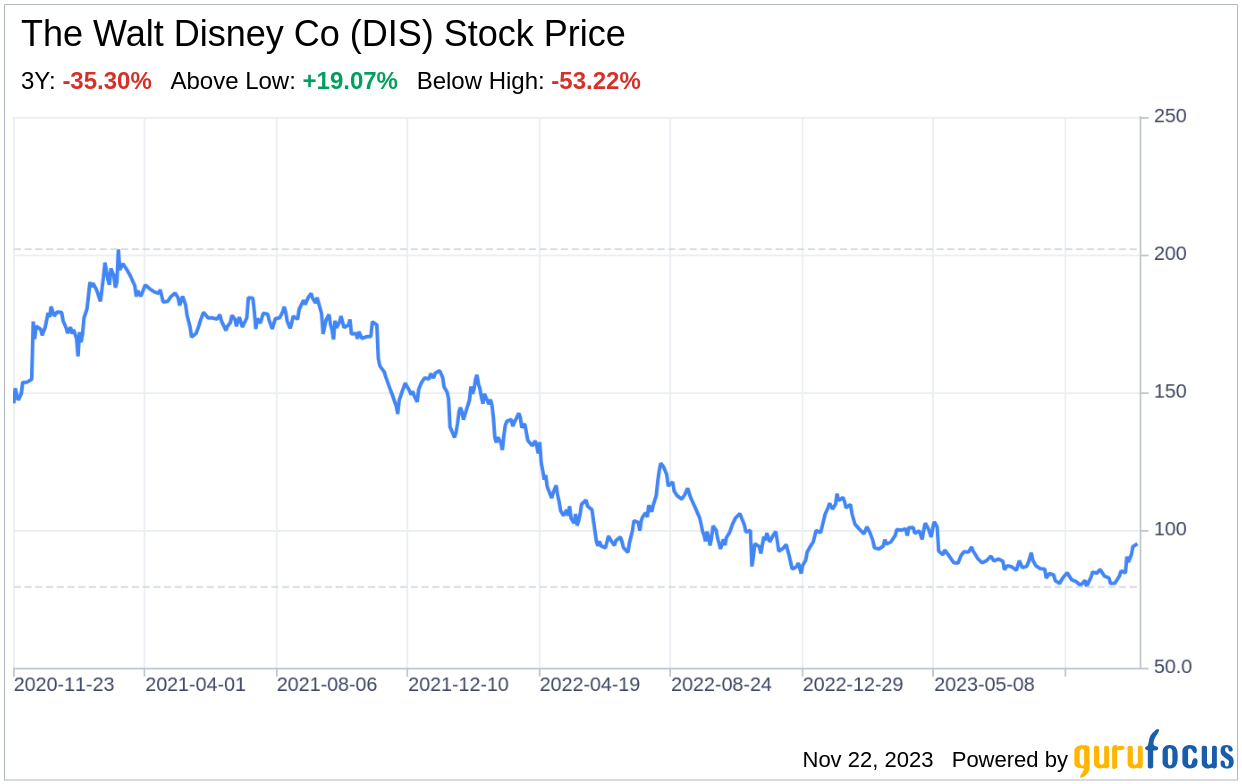On November 21, 2023, The Walt Disney Co (DIS, Financial) filed its annual 10-K report, revealing a comprehensive view of its financial performance and strategic positioning. The company, known for its iconic characters and global entertainment dominance, reported total revenues of $88,898 million for the fiscal year 2023, a notable increase from $82,722 million in 2022. Despite higher revenues, net income attributable to Disney decreased to $2,354 million from $3,145 million the previous year, reflecting a complex operating environment. This SWOT analysis delves into Disney's strengths, weaknesses, opportunities, and threats, providing investors with a nuanced understanding of the company's prospects.

Strengths
Global Brand Recognition and Diverse Portfolio: The Walt Disney Co's brand is unparalleled in the entertainment industry, with a legacy that spans nearly a century. Its diverse portfolio includes theme parks, media networks, and a vast array of beloved characters and stories. In 2023, Disney's services revenue stood at a robust $79,562 million, underscoring the strength of its brand in attracting consumers to its various offerings. The company's ability to leverage its intellectual property across multiple platforms, from blockbuster films to immersive theme park experiences, creates a unique competitive advantage that drives consumer loyalty and revenue growth.
Content Creation and Distribution Prowess: Disney's acquisition of studios such as Pixar, Marvel, and Lucasfilm has fortified its position as a content powerhouse. The company's strategy of producing high-quality, franchise-based content has proven successful, with its films and series resonating with global audiences. Furthermore, Disney's strategic shift to a streaming-focused firm, with over 235 million subscribers across its platforms as of September 2022, highlights its commitment to evolving with industry trends and capitalizing on the direct-to-consumer market.
Weaknesses
Streaming Segment Profitability: Despite the impressive subscriber growth for Disney's streaming services, the segment has yet to reach profitability. The 2023 10-K filing reveals that Disney's DTC offerings have experienced significant losses, indicating the high costs associated with content creation, marketing, and platform development. This weakness is exacerbated by the competitive landscape of the streaming industry, where content acquisition and retention are costly endeavors that can strain financial resources.
Operational Costs and Efficiency: The Walt Disney Co faces challenges in managing its operational costs, which have a direct impact on profitability. The total costs and expenses for 2023 amounted to $79,906 million, a substantial figure that includes costs of services, products, and restructuring charges. While investments in the business are necessary for growth, Disney must continually seek ways to optimize its cost structure and improve efficiency to enhance its bottom line.
Opportunities
International Expansion and Market Penetration: Disney's global brand appeal presents significant opportunities for international expansion, particularly in emerging markets where demand for entertainment content is growing. With the international success of Disney+ and the potential for further penetration in regions like Asia and Latin America, Disney has the opportunity to diversify its revenue streams and reduce reliance on saturated domestic markets.
Technological Innovation and New Business Models: The entertainment industry is rapidly evolving with advancements in technology, such as augmented and virtual reality, and Disney is well-positioned to capitalize on these trends. By embracing new technologies and exploring innovative business models, such as the integration of AI in content creation or the development of immersive experiences, Disney can enhance its offerings and create new revenue opportunities.
Threats
Intense Competition in the Entertainment Industry: The Walt Disney Co operates in a highly competitive industry, with numerous players vying for consumer attention and spending. The rise of alternative entertainment platforms and the proliferation of content creators have intensified the competitive landscape, putting pressure on Disney to continuously innovate and invest in its content and services to maintain its market position.
Changing Consumer Behaviors and Preferences: Consumer behaviors and preferences are constantly evolving, influenced by technological advancements and cultural shifts. Disney must navigate these changes, particularly as younger audiences gravitate towards digital platforms and diverse content offerings. Adapting to these shifts is crucial for Disney to remain relevant and retain its audience base in the face of shifting consumption patterns.
In conclusion, The Walt Disney Co (DIS, Financial) exhibits a strong foundation built on its global brand recognition, content creation capabilities, and strategic shift towards streaming. However, the company must address the challenges of streaming profitability and operational efficiency to sustain its growth. Opportunities for international expansion and technological innovation present pathways for Disney to bolster its market position, while threats from competition and changing consumer behaviors necessitate agility and foresight in strategic planning. As Disney continues to navigate the dynamic entertainment landscape, its ability to leverage its strengths and capitalize on opportunities while mitigating weaknesses and threats will be critical to its long-term success.
This article, generated by GuruFocus, is designed to provide general insights and is not tailored financial advice. Our commentary is rooted in historical data and analyst projections, utilizing an impartial methodology, and is not intended to serve as specific investment guidance. It does not formulate a recommendation to purchase or divest any stock and does not consider individual investment objectives or financial circumstances. Our objective is to deliver long-term, fundamental data-driven analysis. Be aware that our analysis might not incorporate the most recent, price-sensitive company announcements or qualitative information. GuruFocus holds no position in the stocks mentioned herein.
